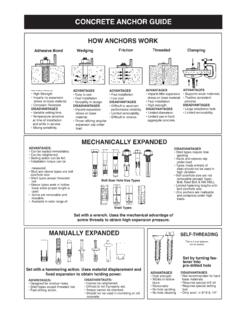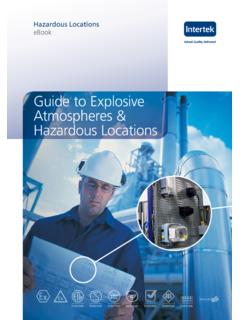Transcription of Electrical Safety For General Industry
1 1 Train-the-Trainers guide to Electrical Safety For General Industry A Review of Common OSHA Regulations and Workplace Violations 2 Table of Contents Common Electrical Hazards .. 5 It s Your Life Protect it! .. 5 How Much Electricity is Dangerous .. 5 Burn Hazards Associated With Electricity .. 6 Definition of Arc Flash .. 6 Typical Results from an Arc Flash .. 7 Approach / Protection Boundaries .. 7 How to Determine the Approach Boundaries .. 8 Nature of Electrical Accidents .. 9 Ways to Protect the Workers .. 9 What if we Can t Deenergize the Equipment .. 10 Lockout and Tagout .. 11 If You Must Work on Energized Circuits .. 12 Who is a Qualified Worker .. 12 Personal Protective Equipment .. 14 PPE for the Head .. 14 PPE for the Eyes & Face .. 16 PPE for the Body (FR Clothing) .. 17 Inspection & Maintenance of FR Clothing .. 17 PPE for the Hands (Gloves) .. 18 Protective Glove Type s .. 18 Protective Glove Classification.
2 19 Rotating Glove Colors .. 20 Maintenance of PPE .. 21 Glove Air Tests .. 22 Electrical Testing of Electrical Protective Equipment .. 22 Other Protective Equipment .. 23 Training Required for PPE .. 24 Re-training the Employee .. 24 How to Determine What PPE Must be Worn .. 25 Guidance From NFPA 70E .. 25 Hazardous (Classified) Locations .. 28 Hazardous Location Types .. 29 Hazardous Location Conditions .. 30 Nature of Hazardous Substances .. 31 An Alternate to Divisions .. 33 3 Groups Within the Zone .. 34 Zone or Division Which Way Should I Go .. 34 Sources of Ignition .. 35 Equipment Design and Construction .. 35 Sealing of Equipment .. 38 Wiring Methods and GFCI .. 40 Protecting Employees .. 40 What is a GFCI .. 40 Where are Temporary GFCI s 40 Where are Permanent GFCI s Required .. 41 What About Protection on Other Systems .. 42 Are Extension Cords Allowable by OSHA .. 42 Permitted Use of Flexible Cords .. 42 Prohibited Use of Flexible Cords.
3 43 Inspections of Extension Cords .. 43 Overcurrent Protection Devices .. 44 Disconnecting Means of Motors .. 46 Cabinets, Boxes and Fittings .. 46 Other Prohibited Wiring Uses .. 46 Temporary Power and Lighting .. 47 4 This material was produced by the Workplace Safety Awareness Council, a 501(c)(3) not-for-profit organization dedicated to Safety in the workplace. For further information about the council or upcoming Safety related training, please visit our website at or call us at (863) 537-4053. This publication is designed to provide accurate and authoritative information about Electrical hazards in the General Industry workplace. It is provided with the understanding that the publisher is not engaged in rendering legal, accounting or other professional services. If legal or expert assistance is required, the services of a competent professional should be sought. This material was produced under grant number SH-16615-07-60-F-12 from the Occupational Safety and Health Administration, Department of Labor.
4 It does not necessarily reflect the views or policies of the Department of Labor, nor does mention of trade names, commercial products, or organizations imply endorsement by the Government. Questions of Comments? Contact: The Workplace Safety Awareness Council 8350 McCoy Road Fort Meade, Florida 33841 (863) 537-4053 5 Common Electrical Hazards It s Your Life Protect it! It s not a secret electricity can be dangerous and when things go wrong lives can be at stake! According to the Bureau of Labor Statistics, 289 employees were killed by contact with electric current in 2002. This equates to more than one work related death every work day in America! Between 1992 and 2001 an average of 4,309 employees lost time away from work because of Electrical injuries. Even if an injured employee doesn t die as a result of their exposure to electricity, the recuperation period can be long, painful and expensive.
5 The goal of this training module is to keep employees health and maintain a quality of life that we all deserve! How Much Electricity is Dangerous Current through the body, even at levels as low as 3 milliamperes, can also cause injuries of an indirect or secondary nature in which involuntary muscular reaction from the electric shock can cause bruises, bone fractures and even death resulting from collisions or falls ( fall from a ladder after receiving a small shock). Current Effect - 3 mA Tingling sensations 3 10 mA Muscle contractions (painful) 10 40 mA Can t Let Go phenomena 30 75 mA Respiratory paralysis (possibly fatal) 100 200 mA Ventricular fibrillation (likely fatal) 200 500 mA Heart clamps tight A Tissue and organs begin to burn Typical effects on the human body based on exposure 6 fast Fact: A 15 amp circuit breaker was designed to protect equipment not people!
6 Burn Hazards Associated With Electricity Human skin provides great protection from normal elements; however human skin provides poor protection from extreme heat which is a byproduct of exposure to electricity. Typically there exist three types of burns: Electrical burns happen when electric current flows through tissues and organs. Arc burns result from high temperatures (up to 35,000 F) when an arc flash event occurs. Thermal burns typically happen when skin touches a hot surface fast Fact: It doesn t take much for human skin to burn in fact an exposure of 203 F for just one-tenth of a second (6 cycles) is enough to cause a third degree burn! Definition of Arc Flash Simply put, an arc flash is a phenomenon where a flashover of electric current leaves its intended path and travels through the air from one conductor to another, or to ground. The results are often violent and when a human is in close proximity to the arc flash, serious injury and even death can occur.
7 7 Arc flash can be caused by many things including: Dust Dropping tools Accidental touching Condensation Material failure Corrosion Faulty Installation Three factors determine the severity of an arc flash injury: Proximity of the worker to the hazard Temperature Time for circuit to break Because of the violent nature of an arc flash exposure when an employee is injured, the injury is serious even resulting in death. It s not uncommon for an injured employee to never regain their past quality of life. Extended medical care is often required, sometimes costing in excess of $1,000,000. Typical Results from an Arc Flash Burns (Non FR clothing can burn onto skin) Fire (could spread rapidly through building) Flying objects (often molten metal) Blast pressure (upwards of 2,000 lbs. / ) Sound Blast (noise can reach 140 dB loud as a gun) Heat (upwards of 35,000 degrees F) Approach / Protection Boundaries The National Fire Protection Association (NFPA) has developed specific approach boundaries designed to protect employees while working on or near energized equipment.
8 These boundaries are: Flash Protection Boundary (outer boundary) Limited Approach Restricted Approach Prohibited Approach (inner boundary) 8 Flash Protection Boundary (outer boundary): The flash boundary is the farthest established boundary from the energy source. If an arc flash occurred, this boundary is where an employee would be exposed to a curable second degree burn ( calories/cm2) Limited Approach: An approach limit at a distance from an exposed live part where a shock hazard exists. Restricted Approach: An approach limit at a distance from an exposed live part which there is an increased risk of shock. Prohibited Approach (inner boundary): A distance from an exposed part which is considered the same as making contact with the live part. This distance is not common between equipment. Some equipment will have a greater flash protection boundary while other equipment will have a lesser boundary.
9 How to Determine the Approach Boundaries Since different equipment will have different approach boundaries, calculations must be made on each piece of equipment. There exists a number of ways to establish these boundaries and the method you select depends on personal preference, resources available and quality desired. 9 Here are a few of the methods available: NFPA Tables: Refer to NFPA 70E 2000 Table or Table (C)(9)(a) NFPA 70E 2004. Since you re referring to established tables, this method is the easiest and quickest however it provides the least amount of accuracy. Formula Method: NFPA 70 E and IEEE Standard 1584 provides formulas that can be used to accurately determine the approach boundaries. This method is time consuming, requires an engineer level of expertise and is subject to human error. Approach Calculator: IEEE has provided a spreadsheet based calculator to assist in determining approach boundaries.
10 Although this calculator does help expedite the calculations, detailed information about the equipment and circuit is still required and this often necessitates the use of an Electrical engineer. Software: There exists on the market various software products that can simplify and expedite the approach boundary calculations. The software may also be able to create one-line diagrams and approach boundary warning labels as required by NFPA 70E. Nature of Electrical Accidents Electrical incidents are caused by many different events; however we can identify three common root causes for just about any Electrical incident: Working on unsafe equipment and installations; Unsafe Environment ( wet environment / presence of flammable vapors); and Unsafe work performance Ways to Protect the Workers There exists a number of ways to protect workers from the threat of Electrical hazards. Some of the methods are for the protection of qualified employees doing work on Electrical circuit and other methods are geared towards non-qualified employees who work nearby energized equipment.

















